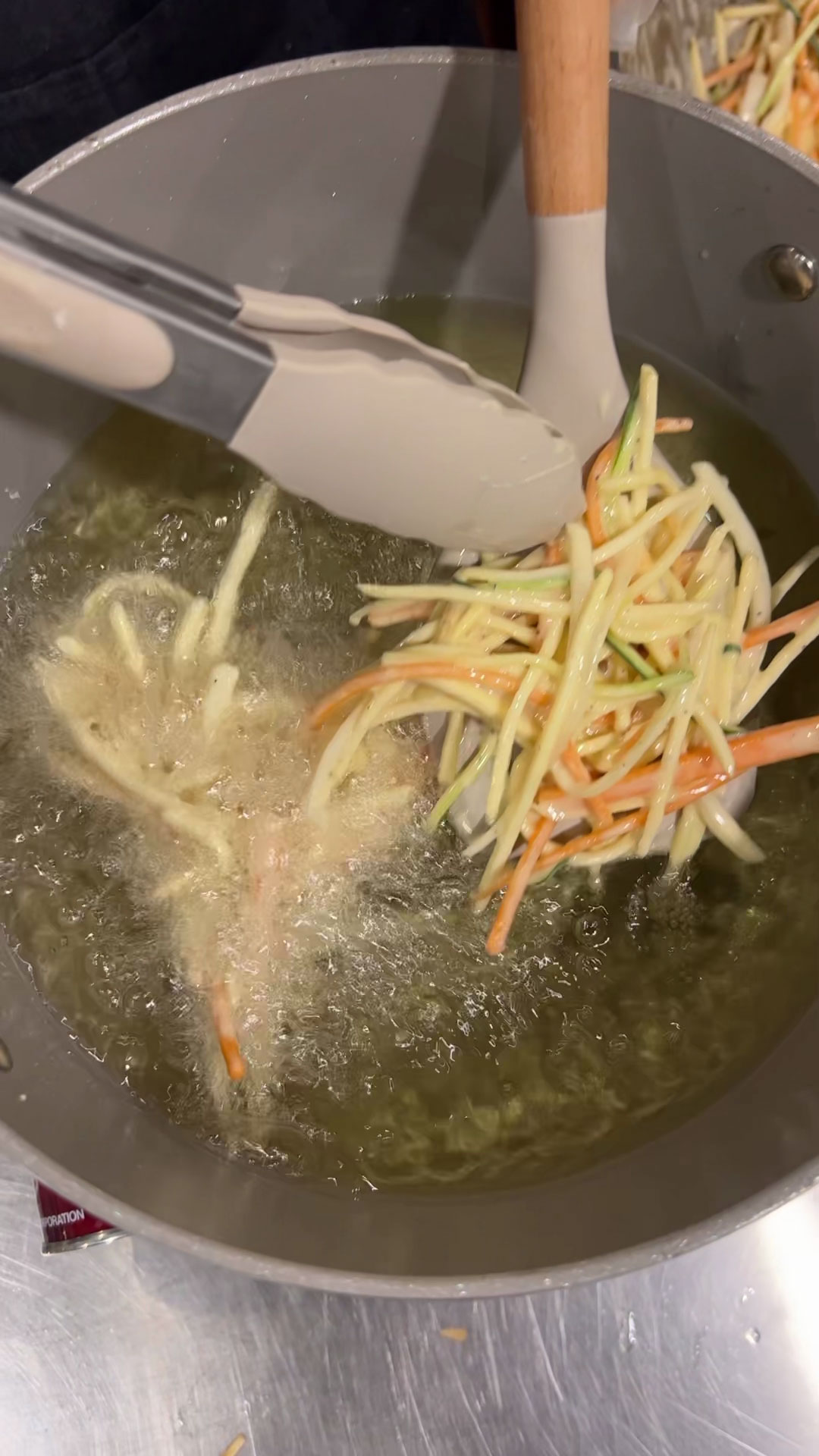
Yachae Twigim is light and crunchy deep-fried vegetables that are crispy on the outside and hearty on the inside—this is the Korean version of Japanese Tempura.
Yachae Twigim or Fried Vegetable Tempura is made from strands of onion, zucchini, carrots, and sweet potato bonded together by a light and crispy batter. While the strands are crispy on the outside, you can taste the heartiness of the variety of veggies inside.
This recipe is tried and tested because I initially made it for my son’s daycare potluck. I had to experiment with several recipes because I wanted my son’s friends to like it. Kakaka~
This is a perfect snack, appetizer, or side dish for sharing. In this recipe, I’ll share how I kept it crispy throughout the day, which made everyone enjoy it thoroughly! Even I couldn’t stop eating it when I was making it!
Ingredients for Yachae Twigim
Disclaimer: I get a small commission at no additional cost to you when you make a qualified purchase under the affiliate links.
Assorted Vegetables

The main vegetables I used in this recipe are onions, zucchini, carrots, and sweet potato. But aside from that, you can also use green onion, mushrooms, pumpkin, bell pepper, and potatoes or 600 grams of vegetables in total for this recipe. As much as possible, use different colored vegetables so the combination is pretty.
Twigim Batter
- Flour – The main binder of the batter
- Potato Starch – Helps absorb moisture and adds crispiness to the batter
- Salt and Pepper – For seasoning, add to taste
- Egg – You can skip the egg for dietary restrictions, but I like to add one for additional flavor.
- Cold Water – To hydrate the batter. The cold water will also help with the crispiness of the twigim.
Step-by-Step Instructions on How to Make Yachae Twigim
Prepare the Vegetables

Wash the vegetables before slicing so they are already clean and dry when sliced, then chop them into equal matchstick sizes so they can clump together properly and cook evenly.



Quick tip, slice the vegetables thinly, stack them overlapping, then slice them julienne. Alternatively, use a mandolin so it’s easier, but handle it carefully as some vegetables are too hard for the mandolin.
Also note that when you’re working with potatoes or sweet potatoes, they will quickly oxidize or turn brown once peeled so you can either soak them in water while working on the rest of the ingredients or work on it last so you can add it to the batter right away.
Make the Twigim Batter


In a bowl, combine flour, potato starch, salt, pepper, egg, and cold water. Mix it well until smooth and the consistency is not too loose or not too thick, just in between.


In a bigger bowl, combine julienned vegetables, then add the twigim batter, and mix it well with your hand for that “son mat” or “hand taste” until everything is coated with the batter.
Prepare the Fryer

In a deep pot, put about 3 inches deep of oil and place it on medium-high heat. Let the oil heat up to 350F, but be careful that it does not produce white smoke which means it’s already too hot.
Take one strand of the vegetable and put it in the fryer. The veggie should float and bubble–this means the oil is ready.
This will take a bit of time so be patient! As a quick tip, if you are able to work quickly, you can heat up the oil while preparing the vegetables.
Fry the Vegetable Tempura


Take a handful of the battered vegetables, lay it flat on a spatula, then slide it into the hot oil. The oil should be at the right temperature so it binds the vegetables right away. Add another handful of vegetables after 5-10 seconds so that they don’t stick with one another.

Cook each tempura for 2-3 minutes per side until lightly golden brown. Once golden brown, take the vegetable tempura, shake off any excess oil, and place it on a wire rack to drain. Repeat this process until you finish all the battered vegetables.
In between batches, remove any crumbs from the batter to prevent it from burning and sticking to the new batch as this will affect the flavor of the tempura.
Recipe FAQ

How do you make the fried vegetable tempura crispy?
- Ensure the batter is the right consistency. Loose batter won’t bind the vegetables, thick batter will make the tempura too cakey.
- Ensure the oil is at the right temperature. Keep the oil at 350F, if the batter is not hot enough, it will take longer to cook, making the vegetables absorb the oil, and turning it soggy. If the batter is too hot, it may burn on the outside, but still raw on the inside.
- Remember not to overcrowd the fryer as it can also decrease the temperature of the oil. In the same way, as you take time to cook, it can also make the oil too hot, so you can turn off the heat for a few minutes so it can cool down a little bit. Either way, keep the fryer temp at 350F.
- Use a wire rack to cool the tempura properly on top and at the bottom. This will provide air circulation which will prevent moisture, keeping the tempura crispy.
Bonus tip: If you plan to bring this at potlucks, let it cool properly, then pack it loosely covered so moisture will not build up.
What dipping sauce can I use for the vegetable tempura?
You can serve these fried vegetables with the sauces I used in these recipes: soft tofu side dish, soy-marinated onion, or soy-marinated egg.
Alternatively, you can also serve this with tteokbokki—dip the twigim in that tteokbokki sauce and one of the best food pairings!
How to reheat leftover vegetable tempura?
As it cools and as you store it in the fridge, it will lose its crispiness. Reheat it in an air fryer or oven toaster either at 300F for 15-20 minutes or 350F for 4-5 minutes. Check until desired crispiness is reached.
What oil do you use for frying?
I use vegetable oil in frying, but you can use any oil with a high smoke point like peanut oil, avocado oil, or canola oil.
What do you do with the frying oil after? Can you reuse it?
Yes, you can reuse oil. To properly keep it, remove any remaining food crumbs in the oil, let it cool down, then store it in a clean bottle or container and in the fridge for up to three weeks.
Dispose of oil if it has turned cloudy, has darkened, or has changed odor.
How to dispose of used oil?
Place used oil on a bottle, then throw it in the garbage. Do not throw oil down the drain.
Other appetizers you might like:
- Spicy Stir Fried Squid
- Korean Seafood Pancake
- Shrimp Pancake
- Royal Court Tteokbokki
- Mini Beef Patties
Make sure to leave a rating, a comment, or tag me on Facebook, Instagram, or Tiktok when you chop them up! Yeobosayo!
Yachae Twigim (Fried Vegetable Tempura)
Equipment
- Deep Pot For frying
Ingredients
600 grams of Vegetable in Total
- 1 whole Large Onion
- 1 whole Medium Zucchini
- 1 whole Large Carrots
- 2 whole Small Sweet Potatoes or Potatoes
Twigim Batter
- 1 cup All Purpose Flour
- 1/4 cup Potato Starch
- 1/2 tbsp Salt
- Pepper To taste
- 1 pc Egg
- 1 cup Water
Instructions
- Peel the vegetables, wash them, then pat them dry.
- Slice the onion julienne, then slice the zucchini, carrots, and sweet potatoes about the same length. You can use a mandolin to make the preparation easier.
- In a separate bowl, combine flour, potato starch, salt, pepper, egg, water, and mix it all together. Check the consistency, it should be smooth, not too loose nor too thick.
- In a big bowl, mix all the julienned vegetables together. Add the batter to the vegetables and mix it thoroughly with your hand ensuring every strand is covered.
- In a deep pot, fill it up to about 3 inches deep of oil and heat it up to 350F. When you put the vegetable in the pot, it should bubble and float–this indicates the oil is ready.
- Take a handful of the battered vegetables, lay it flat on a spatula, and gently place it in the hot oil. Add another handful of vegetables only after 5-10 seconds. Do this until there is no more space on the fryer, but do not overcrowd.
- Cook the vegetable tempura for 2-3 minutes on each side until they are lightly brown.
- Once cooked, take the fried vegetable tempura, shake off the excess oil, and repeat the process until you finish off the battered vegetables.
- Serve hot and crispy, with a soy dipping sauce, and enjoy!






Leave a Reply